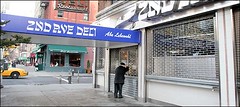Longing for Love and the struggle for the legal tender
(with apologies to Jackson Browne).
I am co-opening a cafe-market sometime in the second quarter of this year. Part of the reason is because I think over time I can make a lot of money. Another is that I am tired of telling people what to do and they don't do it (and fail) so I might as well make money doing it. It's also an interesting intellectual challenge--building a concept with robust operating systems that is successful and can be replicated (making me even more money).
Anyway, my business partner sent me this article from Slate Magazine, "Bitter Brew: I opened a charming neighborhood coffee shop. Then it destroyed my life," about one person's experience in the business. I reacted pretty strongly to this part of the article:
The failure of a small cafe is not a question of competence. It is a sad given. The logistics of a food establishment that seats between 20 and 25 people (which roughly corresponds to the definition of "cozy") are such that the place will stay afloat—barely—as long as its owners spend all of their time on the job. There is a golden rule, long cherished by restaurateurs, for determining whether a business is viable. Rent should take up no more than 25 percent of your revenue, another 25 percent should go toward payroll, and 35 percent should go toward the product. The remaining 15 percent is what you take home. There's an even more elegant version of that rule: Make your rent in four days to be profitable, a week to break even. If you haven't hit the latter mark in a month, close.
This is what I wrote to the author and to my business partner (edited and slightly augmented)--
Good article, but your rent metrics are way off (and the major factor in why such businesses fail). The rule of thumb in the Main Street commercial district revitalization model is that a retailer should pay no more than 4-10% of gross revenue in rent. Because restaurants have higher volumes, they often pay as much as 15% in rent, especially high-volume, great location places (i.e., on Union Square in NYC).
Many independent retailers, restaurants or other, aren't too sophisticated, and end up paying more like your 25% number. So they never make enough money to get ahead. (This is why in my blog on entries on building independent retail I constantly discuss the issues of prevailing rental rates for retail spaces.)
Today's and yesterday's New York Times reports that a rent dispute has closed the "famed" Second Avenue Deli in Manhattan. (I've eaten there and I didn't think the food was all that great, but then I compare all delis to Zingerman's in Ann Arbor, which is one of the absolute top delis in the United States.) See Hold the Mustard, Maybe Forever.
 Marilynn K. Yee/The New York Times. The Second Avenue Deli at Tenth Street, which has been a gastronomical and cultural fixture on the Lower East Side for half a century, may go out of business. The property owner is asking for a 25-37.5% increase in rent (which the restaurant owner agreed to 15 years ago in the lease). But has the business increased by $1 million, which could justify the increased expense?
Marilynn K. Yee/The New York Times. The Second Avenue Deli at Tenth Street, which has been a gastronomical and cultural fixture on the Lower East Side for half a century, may go out of business. The property owner is asking for a 25-37.5% increase in rent (which the restaurant owner agreed to 15 years ago in the lease). But has the business increased by $1 million, which could justify the increased expense?The other thing that I find is that independent business people tend to think they know everything already and aren't likely to read trade magazines (i.e., Restaurant Business, Fresh Cup, Specialty Coffee Retailer, http://www.restaurantowner.com/) and books in the field (such as Bean Business Basics - Second Edition or Effective and Essential Marketing for the Specialty Coffee Retailer -- both from the consultants Espresso101 ), or avail themselves of learning opportunities such as trade shows.
So they fall further behind by not learning and implementing best practices without having to learn most of these lessons from very expensive loss-based experiences, if they have the ability to pull out meta-learning from their own experiences anyway...
One of the best books out there is Pour Your Heart Out by the chairman of Starbucks. He should never have been allowed to write it.
And I won't even get into the costs and difficulties of "market development" and educating customers in new concepts (Vienna coffee) without being well-capitalized.
But as you so rightly point out, size does matter. The number of seats, expected volume, and rent all make a difference on whether you can "fall in love" with a restaurant or make a living from one.
This is something I wrote about restaurants from the perspective of how they aid in revitalization of emerging and transitioning traditional commercial districts:
Richard's Rules for Restaurant-Driven Revitalization (Updated)
There are places that can't make it, because the rents are too high for the volume that can be generated (restaurant as love). But it bugs me when people have the money but don't know what to do with it when they open, and as a result they fail in a place where they didn't have to (restaurant as business), and people thinking about that same district beg off, taking such business failures as a recommendation against the district rather than the business capabilities of the owner.
Index Keywords: retail



0 Comments:
Post a Comment
<< Home